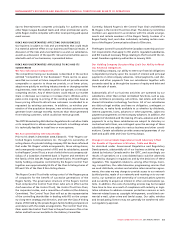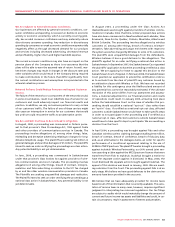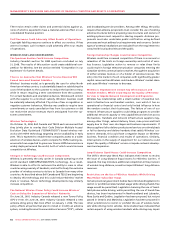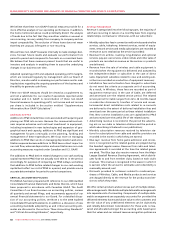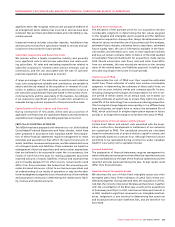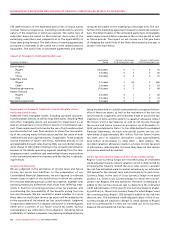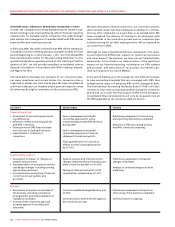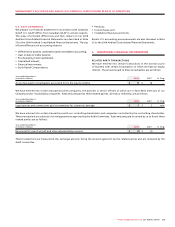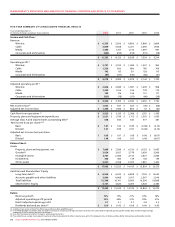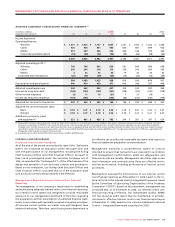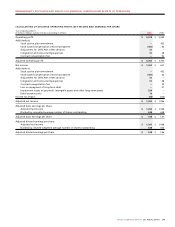Rogers 2008 Annual Report Download - page 75
Download and view the complete annual report
Please find page 75 of the 2008 Rogers annual report below. You can navigate through the pages in the report by either clicking on the pages listed below, or by using the keyword search tool below to find specific information within the annual report.
ROGERS COMMUNICATIONS INC. 2008 ANNUAL REPORT 71
MANAGEMENT’S DISCUSSION AND ANALYSIS OF FINANCIAL CONDITION AND RESULTS OF OPERATIONS
CICA 3862 requires entities to provide disclosures in their finan-
cial statements that enable users to evaluate the significance of
financial instruments on the entity’s financial position and its per-
formance and the nature and extent of risks arising from financial
instruments to which the entity is exposed during the period and at
the balance sheet date, and how the entity manages those risks.
CICA 3863 establishes standards for presentation of financial
instruments and non-financial derivatives. It deals with the clas-
sification of financial instruments, from the perspective of the
issuer, between liabilities and equities, the classification of related
interest, dividends, gains and losses, and circumstances in which
financial assets and financial liabilities are offset.
The adoption of these standards did not have any impact on the
classification and measurement of our financial instruments. The
new disclosures pursuant to these new Handbook Sections are
included in Note 15 of the 2008 Audited Consolidated Financial
Statements.
RECENT C ANADIAN ACCOUNTING PRONOUNCEMENTS
Goodwill and Intangible Assets
In 2008, the CICA issued Handbook Section 3064, Goodwill and
Intangible Assets (“CICA 3064”). CICA 3064, which replaces Section
3062, Goodwill and Intangible Assets, and Section 3450, Research
and Development Costs, establishes standards for the recognition,
measurement and disclosure of goodwill and intangible assets.
The provisions relating to the definition and initial recognition of
intangible assets, including internally generated intangible assets,
are equivalent to the corresponding provisions of IFRS IAS 38,
Intangible Assets. This new standard is effective for our Interim and
Annual Consolidated Financial Statements commencing January 1,
2009. We are assessing the impact of the new standard.
the pension plan of the Company as there is no assurance that the
plan will be able to earn the assumed rate of return. As well, mar-
ket driven changes may result in changes in the discount rates and
other variables which would result in the Company being required
to make contributions in the future that differ significantly from
the current contributions and assumptions incorporated into the
actuarial valuation process.
The following table illustrates the increase (decrease) in the accrued
benefit obligation and pension expense for changes in these pri-
mary assumptions and estimates:
Pension Plans
When accounting for defined benefit pension plans, assumptions
are made in determining the valuation of benefit obligations and
the future performance of plan assets. Delayed recognition of dif-
ferences between actual results and expected or estimated results
is a guiding principle of pension accounting. This principle results
in recognition of changes in benefit obligations and plan perfor-
mance over the working lives of the employees receiving benefits
under the plan. The primary assumptions and estimates include the
discount rate, the expected return on plan assets and the rate of
compensation increase. Changes to these primary assumptions and
estimates would impact pension expense and the deferred pension
asset. The current economic conditions may also have an impact on
Impact of Changes in Pension-Related Assumptions
Accrued Benefit Obligation at Pension Expense
(In millions of dollars) End of Fiscal 2008 Fiscal 2008
Discount rate 6.75% 5.65%
Impact of: 1% increase $ (80) $ (9)
1% decrease 104 11
Rate of compensation increase 3.00% 3.25%
Impact of: 0.25% increase $ 4 $ 1
0.25% decrease (3) (1)
Expected rate of return on assets N/A 7.00%
Impact of: 1% increase N/A 6
1% decrease N/A (6)
Allowance for Doubtful Accounts
A significant portion of our revenue is earned from selling on credit
to individual consumers and business customers. The allowance for
doubtful accounts is calculated by taking into account factors such
as our historical collection and write-off experience, the number
of days the customer is past due and the status of the customer’s
account with respect to whether or not the customer is continuing
to receive service. As a result, fluctuations in the aging of subscriber
accounts will directly impact the reported amount of bad debt
expense. For example, events or circumstances that result in a dete-
rioration in the aging of subscriber accounts will in turn increase
the reported amount of bad debt expense. Conversely, as circum-
stances improve and customer accounts are adjusted and brought
current, the reported bad debt expense will decline.
NEW ACCOUNTING STANDARDS
Capital disclosures
Effective January 1, 2008, we adopted the new recommendations
of The Canadian Institute of Chartered Accountants’ (“CICA”)
Handbook Section 1535, Capital Disclosures (“CICA 1535”). CICA
1535 requires that an entity disclose information that enables users
of its financial statements to evaluate an entity’s objectives, poli-
cies and processes for managing capital, including disclosures of
any externally imposed capital requirements and the consequences
for non-compliance. These new disclosures are included in Note 21
of the 2008 Audited Consolidated Financial Statements.
Financial instruments
Effective January 1, 2008, we adopted the new recommendations
of CICA Handbook Section 3862, Financial Instruments - Disclosures
(“CICA 3862”), and Handbook Section 3863, Financial Instruments -
Presentation (“CICA 3863”).


